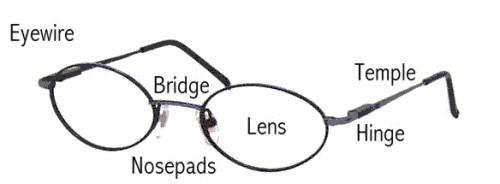How Are Eyeglass Frames Different For Kids?
Only 10% of all eyeglass frames made are for children. This is a very small market and often frame manufacturers will only have a token presence in the segment, perhaps 1-5 different styles. These manufacturers will often not make the necessary modifications to truly fit a child properly or strengthen the structure to increase it durability to fit a child's active lifestyle. I use only the manufacturers who have dedicated themselves to bringing children safe and durable glasses. The following is a list of minimum components that qualifies a frame as a good pair for a child:
It All Hinges On This:
Hinges are the small interlocking leaves of metal that attach the frame front (called the eye wire, see below) to the side pieces. Like their gargantuan big brothers on doors, open hinges hold the eye wire at a right angle to the side piece (the temple).  More and more frequently, manufacturers are installing spring hinges rather than static hinges. Spring hinges allow the side pieces to flex away from the child's head and to "spring" back again to the original adjustment. These hinges will compensate for those slight bumps into walls, floors, other children, wild animals and pet elephants. If you buy a pair of glasses without these you could find yourself going in for frequent adjustments, or worse, frequent replacements. A few manufacturers are rolling out split hinges, which are spring hinges that have a second screw to hold them fast. That means that if either one or the other of the screws should come loose or fall out the lens will still remain securely in place.
More and more frequently, manufacturers are installing spring hinges rather than static hinges. Spring hinges allow the side pieces to flex away from the child's head and to "spring" back again to the original adjustment. These hinges will compensate for those slight bumps into walls, floors, other children, wild animals and pet elephants. If you buy a pair of glasses without these you could find yourself going in for frequent adjustments, or worse, frequent replacements. A few manufacturers are rolling out split hinges, which are spring hinges that have a second screw to hold them fast. That means that if either one or the other of the screws should come loose or fall out the lens will still remain securely in place.
(Stainless) Steel Yourself For The Worst:
Non-corrosive durable metals are appropriate to create a safe pair of glasses for children. These materials don't react easily with the oils in a person's skin and become brittle with age (like granny's hips). Hypoallergenic materials such as stainless steel and titanium are also good choices.
C Is For Cable:
Adult temples have ends that perch on top of their ears, which is OK, because parents are never turned upside-down. Children's glasses can come equipped with cables. These are "C" shaped pieces that wrap around your child's ear. I strongly recommend these for infants through toddlers and preschool children wearing glasses for the first time. They also come in handy for very active older children. The cable will allow the glasses to fit snugly while a child is bending over to pick up a toy or being tossed around through the air by dad or Uncle Makemscream.
No-Spaz Nose Pads:
A quality child's frame will have small nose pads with rounded edges to prevent them from digging into a child's tender skin. Vinyl or silicone are the materials of choice. Incidentally, nose pads can be and should replaced by a competent optician and should be done so at the first sign that they are breaking down.
Come On Baby, Do The Twist:
A handful of manufacturers use a titanium alloy that is incredibly flexible. These are the bending twisting frames you may have seen on TV, and yes, they really do work. Generally, these frames do not have spring hinges because they are unnecessary. The entire frame flexes, making an additional spring hinge overkill, like seat belts on a turtle. The entire frame is a spring hinge which bounces back to the original adjustment after a substantial impact. I highly recommend these frames for the energetic child! although they are often more expensive, I've never had a parent regret purchasing them.
Back to our Tips Page
